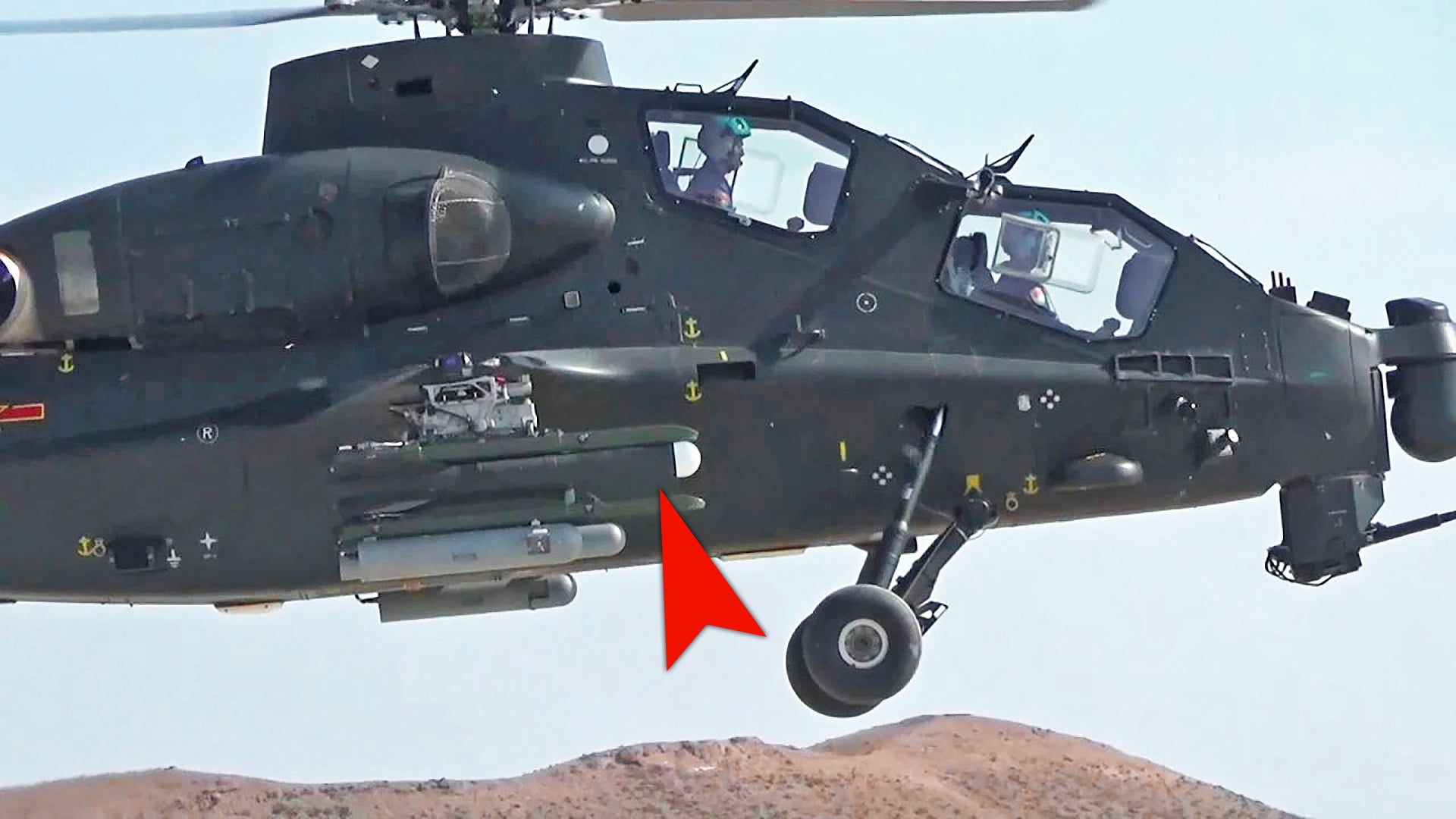Video has emerged from China showing Z-10A attack helicopters from the People’s Liberation Army Ground Force launching what’s reportedly a new type of missile during a live-fire exercise. The footage appeared online after screengrabs showing the new air-to-surface weapon were posted on social media last week. These first images originated from the state-owned China Central Television 13 (CCTV 13) channel and showed crews loading the missiles onto four-round racks on the Z-10A’s outboard stub-wing hardpoints before they were launched at an undisclosed location.
The missiles engaged a variety of armored vehicle targets, including tanks. The range at which these were knocked out is likely indicative of a fire-and-forget weapon and the use of Z-10As in combination with at least one Z-19A suggests that the latter type may have provided targeting data using its mast-mounted millimeter-wave (MMW) radar, forming a hunter-killer team.
You can watch the full video here:

Interestingly, China military expert Andreas Rupprecht, who goes by @RupprechtDeino on Twitter, has suggested that the weapon may already have completed its development and is now in frontline use — or, at least, is undergoing the final phase of pre-service trials.
The anti-tank guided missile (ATGM) bears some resemblance to the China North Industries Corporation (NORINCO) Blue Arrow 21 (BA-21), a weapon that’s thought to have a range of around 11 miles and guidance based on a dual-mode millimeter-wave radar/semi-active laser seeker.
Offered for export at Airshow China at Zhuhai in 2018, the helicopter-launched BA-21 is reportedly an enhanced derivative of the AKD-10 missile that is used by the PLAGF’s Z-10 and Z-19 attack rotorcraft and that is broadly equivalent to the U.S. AGM-114 Hellfire. The Chinese missile has a reported range of around 4.3 miles. While the initial AKD-10 employed semi-active laser guidance, later iterations of the weapon reportedly incorporate an MMW seeker.
Previously, a drone-launched BA-21 version was displayed at Zhuhai in 2016, intended as part of the armory of the Wing Loong II unmanned combat air vehicle, among others.
As well as two missiles on each of the four-round launchers, the Z-10As were also seen carrying unidentified pods mounted below the weapons. The function of this store is unclear, but it has some similarities with training pods used by other helicopters to simulate targets for engagement as well as hits to the aircraft itself.
Another possibility is that these pods contain data-link equipment, which would potentially allow targeting data to be handed from the Z-19A and then passed on to the missile once launched by the Z-10A. This would allow a single radar-equipped helicopter to provide targeting coordinates for multiple Z-10As.
Still, such a system would not offer the same ‘fire-and-forget’ capability that the Apache Longbow system provides. The launching helicopter would have to maintain line-of-sight for a period of time after launch.
Finally, it could be some kind of independent radar illuminator for self-targeting the radio-frequency-guided missiles, but it would probably have to be tied to the helicopter’s electro-optical system, which would seem to defeat the point to some degree.
In addition to employing a new missile, the PLAGF’s Z-10 has recently been active in the maritime domain, with deck trials on board a Type 072A landing ship of the People’s Liberation Army Navy (PLAN), reportedly conducted in the Taiwan Strait.
The Changhe Aircraft Industries Group Z-10 — locally named Pi Li Huo, or Thunderbolt — is the PLAGF’s first modern attack helicopter, first flown in April 2003 and entering service in pre-production form in late 2010.
Before the emergence of this new missile, its main weapons were understood to be eight AKD-9 or AKD-10 ATGMs, plus a 23mm cannon and various rocket pods. It can also be armed with PL-90 air-to-air missiles. Primary sensors are a WXG1006 package in the nose that contains a forward-looking infrared, TV camera, laser rangefinder, and laser designator. The definitive production version for the PLAGF is the Z-10A that incorporates some detailed changes in terms of the targeting system and, perhaps, features uprated engines.
The Z-19, meanwhile, which was seen in the video working alongside the Z-10, was developed by the Harbin Aircraft Industry Group as a light scout/attack helicopter. First flown in May 2010, it reportedly entered service in 2012 and is named Hei Xuan Feng, or Black Cyclone. As well as KD-9 or KD-10 ATGMs and PL-90 AAMs, it can be armed with gun pods and rockets. The definitive Z-19A version is fitted with a mast-mounted MMW phased-array radar, making it an ideal complement to the Z-10 for armed reconnaissance and target designation. It can use this system to locate, classify, prioritize, and engage targets in any weather, day or night. In this case, it may now be able to data-link those targets to a nearby Z-10.
Rupprecht identifies the Z-10As and Z-19As in the video as belonging to the People’s Liberation Army Ground Force’s (PLAGF) 161st Air Assault Brigade, which is assigned to the 83rd Group Army. The brigade is headquartered at Xinxiang, in Henan province and is part of the Central Theater Command.
While we await more details about the Z-10A’s new missile, it’s clear that the People’s Liberation Army is continuing to make serious efforts to improve the capabilities of its attack helicopter fleet — and at the same time, it seems to be refining its concept of operations.
Contact the author: thomas@thedrive.com
